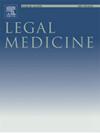The role of legal medicine in the reconstruction of fatalities due to tractor rollovers: from evidence to proof
IF 1.4
4区 医学
Q3 MEDICINE, LEGAL
引用次数: 0
Abstract
Despite advances in engineering solutions, such as rollover protective structures and improved operator training, tractor rollovers in agricultural settings continue to be the main cause of death necessitating medicolegal investigations to reconstruct event dynamics and determine causal attributions. This study examines the distinction between evidence (observational data consistent with a hypothesis) and proof (conclusive data confirming a hypothesis) in the context of fatal tractor accidents. We propose a three-phase logic model which provides a conclusive reconstruction of the events by integrating engineering data, dynamic modelling, death scene analysis and autopsy findings. Careful analysis of the death scene and circumstantial evidence is essential during investigations of rollover dynamics, encompassing operational safety procedures, the technical characteristics of the vehicle, corpse position, autopsy findings, toxicology data, the victim’s medical history and psychophysical condition at the time of the accident occurred. Systematizing such variables within a unified forensic framework enhances the scientific reliability of forensic investigations and the technical reconstruction of the fatality, thus contributing to the development of prevention strategies, liability assessment and the formulation of safety policy.
法律医学在重建因拖拉机侧翻死亡事故中的作用:从证据到证据
尽管在工程解决方案方面取得了进步,例如侧翻保护结构和改进的操作人员培训,但农业环境中的拖拉机侧翻仍然是导致死亡的主要原因,需要进行法医调查,以重建事件动态并确定因果归因。本研究探讨了致命拖拉机事故背景下证据(与假设一致的观察数据)和证明(确认假设的结论性数据)之间的区别。我们提出了一个三相逻辑模型,该模型通过集成工程数据、动态建模、死亡现场分析和尸检结果,提供了事件的结论性重建。在对翻车动力学进行调查时,必须仔细分析死亡现场和间接证据,包括操作安全程序、车辆的技术特征、尸体位置、尸检结果、毒理学数据、受害者的病史和事故发生时的心理生理状况。在统一的法医框架内将这些变量系统化,可以提高法医调查的科学可靠性和死亡的技术重建,从而有助于制定预防战略、责任评估和制定安全政策。
本文章由计算机程序翻译,如有差异,请以英文原文为准。
求助全文
约1分钟内获得全文
求助全文
来源期刊

Legal Medicine
Nursing-Issues, Ethics and Legal Aspects
CiteScore
2.80
自引率
6.70%
发文量
119
审稿时长
7.9 weeks
期刊介绍:
Legal Medicine provides an international forum for the publication of original articles, reviews and correspondence on subjects that cover practical and theoretical areas of interest relating to the wide range of legal medicine.
Subjects covered include forensic pathology, toxicology, odontology, anthropology, criminalistics, immunochemistry, hemogenetics and forensic aspects of biological science with emphasis on DNA analysis and molecular biology. Submissions dealing with medicolegal problems such as malpractice, insurance, child abuse or ethics in medical practice are also acceptable.
 求助内容:
求助内容: 应助结果提醒方式:
应助结果提醒方式:


